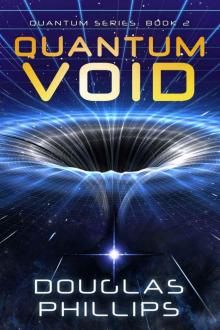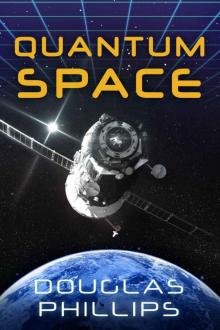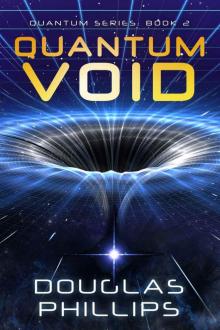- Home
- Douglas Phillips
Quantum Void
Quantum Void Read online
Quantum Void
Book Two in the Quantum Series
By Douglas Phillips
Text and images copyright © 2018 Douglas Phillips
All Rights Reserved.
This is a work of fiction. References to actual places assist in setting a level of realism, however all characters, businesses and events portrayed in the book are products of the author’s imagination. Any resemblance to actual persons, living or dead, businesses or actual events is purely coincidental.
Table of Contents
1Ripples
2PVC
3Briefing
4Katanauts
5Murphy’s Law
6Bosons
7Caps
8Gateway
9Dancers
10Beextu
11Decoherence
12Workers
13Brainwaves
14Singularity
15Electricity
16Regulators
17Fermilab
18Isolation
19Thoughts
20Void
21Florida
22Core
23Eigenstates
24Messages
25Partners
26Visualization
27Duty
28Huddle
29Flickers
30Apparition
31Austin
32Interdimensional
33Particles
34Bluebonnets
35Resolve
36Rabbit Hole
37Probabilities
38Ratios
39Evacuation
40Density
41Non Sequitur
42Intersection
43Rupture
44Passageway
45Kata Zero
46External Observer
Afterword
Acknowledgments
Quantum Time
The science presented in this story is real.
Mostly.
1
Ripples
Friday, May 20
Nala Pasquier slid the bangle bracelet off her wrist and placed it on the security table. The metal detector at the entrance to Wilson Hall was a new addition, a sign of changing times. Fermi National Accelerator Laboratory was once a place known only to the locals of Chicago, but its relative anonymity had disappeared eight months ago. First contact. Life beyond Earth. These days everyone knew about Fermilab and the secrets of the universe uncovered there.
Nala waved to the security guard. “What’s my new word today, Angel?” She correctly pronounced his Spanish name, An-hel.
“Descubrir,” the guard answered with a tight smile.
A particle physicist is not easily stumped, but Nala was forced to pause as she gathered her belongings. “Use it in a sentence.”
“Él descubrió una mosca en la sopa.” Angel crossed his arms, challenging her capacity to learn the language one word at a time. With dark brown skin and a last name that was often confused as Hispanic, most people were surprised when Nala told them she was half Haitian and that French was the language of Haiti, not Spanish.
“Discover?” she asked tentatively. “He discovered a fly in the soup?”
The guard nodded with approval. “Está bien. You got it.”
Nala laughed. “Descubrir. Discover. That’s a good word to know in my business. Thanks Angel. Yo quiero descubrir algo nuevo hoy.”
“You want to discover something new today,” Angel echoed in English. “Your Spanish is getting better, Nala.” His pride was obvious.
“I have a good teacher.” She waved once more and continued into the building’s interior atrium, an open space that soared to skylights far above, mirroring the expansive ambitions of the scientists who worked here.
Perhaps she would discover something today. Her work in the new science of quantum space had advanced by leaps and bounds thanks to a few tips from an alien source. It was an exciting time in particle physics, in part because there was still much more to learn. At their heart, all scientists are lifelong students of nature.
Nala took the elevator to basement level three and then descended two flights of stairs even deeper into the Earth. She walked a long concrete hallway and rounded a corner. The sign on the door hadn’t changed—Diastasi Lab, Authorized Personnel Only—but it no longer took a top-secret security clearance to become one of the authorized few.
Their work with extra dimensions of space was now public knowledge. Government classification had finally been lifted, and Nala was back in touch with colleagues at other labs, former friends who’d thought she’d disappeared off the face of the earth. Her stunned friends, even her mother, had been kept in the dark for years. Um, yeah, Mom, we figured out how to reach into a fourth dimension and compress distances by a factor of a billion.
Spatial compression had already made unmanned spaceflight obsolete. The stars were now within easy reach for any probe, camera or radio link. Interstellar travel for humans was not yet possible, but one step at a time. Earth was now connected into a vast web of alien civilizations. The future was wide open.
Nala tapped her badge on the security pad and pushed open the door. “Morning, Thomas. Sorry I’m late,” she said to the stout red-haired young man at the lab’s workbench. Thomas, her lab assistant, was hunched over a signal generator, one of a hundred electronic components that covered the bench and filled every available shelf and niche in the overcrowded lab.
Thomas looked up with a grin on his bearded face. “Och, you’re a wee scunner, you are.” The accent was fake, but it was also pretty good.
She pulled a chair close to the workbench and turned on a computer. “That’s a new one. Are we Scottish today?”
“For a wee spell, lassie. Perhaps ’til midday lunch,” Thomas replied.
“Or as long as you can keep the Sean Connery accent going?”
“Possibly ’til then, aye.”
Thomas wasn’t Scottish. Or Irish. Or German. He was Russian on most Wednesdays. And every Monday, he became a strange cross between Ricardo Montalbán and the swashbuckling Spanish cat from Shrek. A bit wacky, most definitely an oddball, but mostly Thomas was fun. Anyone with a rebellious streak and a touch of drama was okay in Nala’s book.
“We’ll amp it up a wee bit today, my friend.” She settled into her normal position in front of a set of three large computer displays at one end of the workbench. She tapped the keyboard, a panel with gauges appeared on one display and she moved a slider labeled tau to her chosen value. It was a simple command, but potent, backed by the largest particle accelerator in the United States.
Four floors above in the Fermilab main control room, colleagues who operated the accelerator would be at this very moment awakening the giant machine, inserting protons into its heart, and initializing the powerful magnets that formed the two-mile ring of the Main Injector loop. Soon, those protons would be screaming down a curved pipe at close to the speed of light—eighty thousand laps every second. Most people had a hard time wrapping their head around that kind of speed, so someone had installed a digital counter on the Main Injector tunnel wall, a sort of odometer that ticked once for every thousand laps. As the protons reached full speed, the counter’s digits became a blur.
One hundred twenty-five gigaelectron volts. A beam of protons with that kind of power could burn a hole through your head. It had happened once before in Russia—to a visitor who’d accidentally peered into an opening with a live beam. The results were not pretty.
Nala and Thomas ran down an operational checklist together, validating system status and checking their lab equipment. Thomas adjusted the alignment of a pink pipe that pointed straight into a clear plexiglass box above the workbench. The box was ground zero for the neutrino beam that would shoot through their lab a
t near light speed. Thomas placed a compact webcam inside the box and inserted a rubber tube through a hole, the other end of the tube connected to a large tank of nitrogen.
Finishing her checklist, Nala looked up. “Shall we?”
“All systems are go for launch,” Thomas said, temporarily lapsing into his NASA ground controller’s voice.
Nala picked up a handheld radio from its cradle. “Is Cody working today?”
Thomas nodded. “Aye. That he is.”
She keyed the transmit button. “Cody, Nala. Got anything flying around the loop yet?” The question was purely a courtesy. She could feel a slight vibration in the floor, which meant the accelerator was already spinning particles around its racetrack.
The radio hissed, followed by a man’s voice. “Where’ve you been, Nala? Hell, we’ve been on standby pretty much forever.”
Five minutes late to the lab today. Taunts were just part of the game with these guys. “Okay, that’s enough, smart-ass. We’re ready down here when you are.”
“Stand by.” A few seconds later, a high-pitched hum reverberated from the overhead pipes—the sound of protons, ramping up to obscene energy levels. “One-twenty-five gig,” Cody said. “We’re up to full speed. You’ve got targeting control, but I’ll manage the neutrino oscillation.”
“Gotcha.” She clicked a few times on her computer. “Let ‘em fly.”
“Protons away.”
Somewhere behind a thick concrete wall, a magnetic gate opened and a stream of fast-moving protons blasted through. The particles smashed into their target—a disc of graphite no bigger than a coin. A stream of pions ripped out the other side, decaying in picoseconds to neutrinos and headed straight into Nala’s lab.
The background hum increased dramatically to a loud buzz that filled the room. Thomas put on sunglasses and focused on the webcam inside the plexiglass box. As the pitch of the buzzing reached an irritating level, a brilliant blue flash blasted from the box, accompanied by a loud pop. Thomas didn’t flinch.
When the flash dissipated, the box was empty, and the nitrogen tube had been cleanly sliced where it entered the box. Even after hundreds of launches, the disappearing act never failed to impress.
“Tau is perfect,” Nala said, her eyes glued not to the plexiglass box but to her computer screen. A window popped up showing a live image returned by the webcam, now positioned in another dimension of space.
As it had done a hundred times before, the magic of expanding a quantum-sized dimension forced a corresponding compression of ordinary space. From the perspective of the camera, five hundred million kilometers had just compressed to almost nothing and the planet Jupiter was suddenly within camera distance. The giant planet appeared on cue, beautiful in its color but oddly flat in shape. More like a disc than a sphere, but any three-dimensional object looked that way from quantum space. Compressed, flattened.
“’Tis near enough to spit upon,” Thomas said, his Scottish accent returning. He checked another computer screen. “The 4-D volume looks right. Nitrogen density is 1.24 kilograms per cubic meter—plus the camera. About 10 percent higher than yesterday.” A silly grin appeared on his face. “No sign of any Pasquier waves.”
“Fuck off,” she said with a glare. “You know my opinion on that arrogant bullshit.” Using her last name was another part of the game. They were monitoring for gravitational waves, but Thomas was intent on renaming everything. Last week he’d threatened to submit the Nala boson to a certification board. The week before, the whole Standard Model would be renamed to the Donut Box, with each type of quark and lepton changing to Glazed, Sprinkles, Choco, and so on. Actually, she had kind of liked that one.
Her fake-glare morphed into a smile and she turned to her computer. “Be ready to monitor, my friend. Initiating collapse.”
She pressed a key, and within seconds the surrounding air wavered like heat waves coming from an oven. Her computer screen wavered too, even the surface of the workbench.
That’s not right, she thought. The gravitational waves they sought were so weak as to be nearly undetectable. A slight tremor. A wiggle. This was a sloshing bucket of water.
Ripples propagated through the air and within seconds had permeated the room. The walls, floor and ceiling pulsated in a slow oscillation. Waves penetrated her body, making her own bones feel as pliable as everything else. On an intellectual level the unnatural panorama was eye opening but there was no denying a far more primitive reaction—the feeling of slipping off the edge of a cliff. Both her mind and her heart raced.
“Anomaly!” Nala’s voice sounded like she was at the bottom of a well. She grabbed the handheld radio from its recharger and pressed the transmit button. “Cody, shut it down!”
The edge of the workbench pushed into her hip in rhythmic surges as if it were trying to get her attention. The computer monitors hanging on the wall above the workbench deformed like they were sheets of rubber. Then, as quickly as they had started, the waves dampened.
The air calmed, the floor and the workbench resuming their previously solid existence. On the other side of the lab wall, the enormous particle accelerator spun down until the loudest thing left in the room was Nala’s heart, pounding inside her once-again-solid chest. She leaned against the workbench and took a deep breath.
“Whoa. What the hell?” Any particle physicist routinely dwells in the realm of the bizarre; quantum physics is not for lightweights. But over weeks of experiments, she’d seen no precedent for today’s gymnastics.
Thomas stepped toward her keeping both hands on the workbench. “You okay?” he asked.
“Sure, you?”
“A bit queasy.”
“Yeah, me too.”
They stood in silence for a time. Anomalies are expected in groundbreaking science, even welcomed as opportunities for discovery. But lack of control was always disturbing.
Nala plopped into her chair and turned to the computer display. It showed a line graph that looked like it had just been through an earthquake. “Wow. Tau went crazy there for a minute, even sinusoidal.”
Thomas peered over her shoulder. “And here I thought you smarty-pants physicists had this four-dimensional stuff all figured out.”
Nala took another deep breath, her heart calming. She glanced back at her lab partner. “Yeah… I thought we did too.”
A loud cracking sound caused them both to jump. It came from the plexiglass test box at the other end of the workbench. A tiny light hovered in the center of the box. The light hadn’t been there at the beginning of the test.
It was a pinprick, nothing more, but far more brilliant than any dot ought to be. Nala shielded her eyes and drew closer. A fine mist slowly circled the point of light, forming a disc shape that spiraled inward. It gave the appearance of a miniature galaxy only a few inches across.
“Fascinating,” she said.
As they watched, there was another crack, and a bit of the plexiglass case broke away. The chip joined the mist to be drawn into the point of light. Yet another crack followed, splitting the far side of the box.
“Holy shit,” Nala said, stepping back. “Whatever it is, for such a little thing it’s got some punch.”
And then, as quickly as it appeared, the light silently faded away. The mist twisted delicately for another turn and then evaporated, leaving the box empty once more.
Thomas stood behind, watching the last wisp of the gracefully pirouetting mist. “Kind of pretty,” Thomas said. “But unexpected.”
Nala concentrated her stare into the test box, searching for answers. Both the waves and the pinprick of light were anomalies, no question, unseen in any previous test. Were they related? Could they be re-created? The effect would need more study. They could be on the brink of a landmark discovery. A breakthrough.
Of course, it could be dangerous too.
2
PVC
One month before…
Davis Garrity ran a hand through his wavy gray hair and checked that his tie w
as straight. There wasn’t enough time to stop by the men’s room before the meeting, but his reflection in the polished metal of the elevator doors was sufficient. There was no point in achieving grooming perfection anyway—salesmen did that, and he was certainly no salesman. Davis made deals. Nobody was better.
The elevator doors opened at the twenty-fourth floor of the office building, one of many gleaming glass towers of the downtown core of Austin, Texas. Davis strode down the hallway, briefcase in hand, and pushed open one of the double glass doors etched with a stylized logo featuring a lightbulb and the company name, ElecTrek.
“Davis Garrity for Stan Wasserman,” he told the receptionist.
“Welcome to ElecTrek, Mr. Garrity. Mr. Wasserman would like you to join his team in the east conference room.” Davis signed in and the receptionist pointed the way.
The conference room was directly across from reception, a space designed to be more public than the interior hallways and offices behind secured doors. It was also designed with visitors in mind. Photographs straight out of a shareholders’ annual report adorned the walls. One provided a view of scenic rolling hills with an occasional wind turbine dotting the idyllic scene, almost like an industrial decoration. Another showed a sea of solar panels glinting in the sun. A third displayed a modern power plant with a young family strategically positioned in the foreground, apparently ready for a tour from a smiling guide wearing a hard hat.
Davis set his briefcase on the table, took a seat and waited. He knew it wouldn’t be long. The client was aware he’d already signed one of their competitors. Naturally, their interest was piqued.
A few minutes later, two men and a woman walked in. The taller man reached out with a hand. “Davis, glad you could make it. Stan Wasserman, nice to meet you in person.” Wasserman introduced the others, Teri Barker, chief environmental engineer, and Jake Schroeder, ElecTrek’s vice president for Texas Power Operations.
“Thanks for your time today,” Davis said with an elegant bow of the head. “I can assure you, it’s going to be the best meeting you’ll have all week.” Lesser dealmakers might set expectations low to give the appearance of delivering high, but Davis could afford to start high and stay there. Final delivery would be stratospheric.

 The Quantum Series Box Set
The Quantum Series Box Set Quantum Void (Quantum Series Book 2)
Quantum Void (Quantum Series Book 2) Quantum Space: Book One in the Quantum Series
Quantum Space: Book One in the Quantum Series Quantum Void
Quantum Void